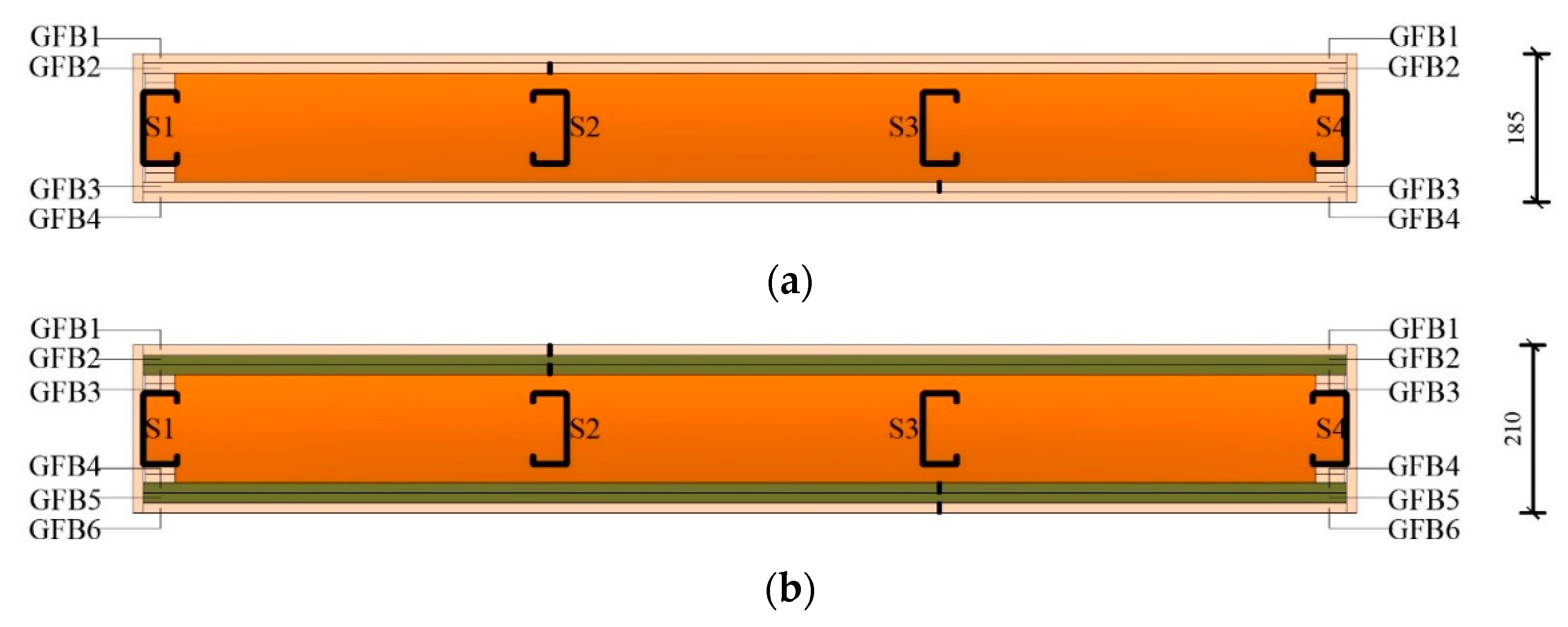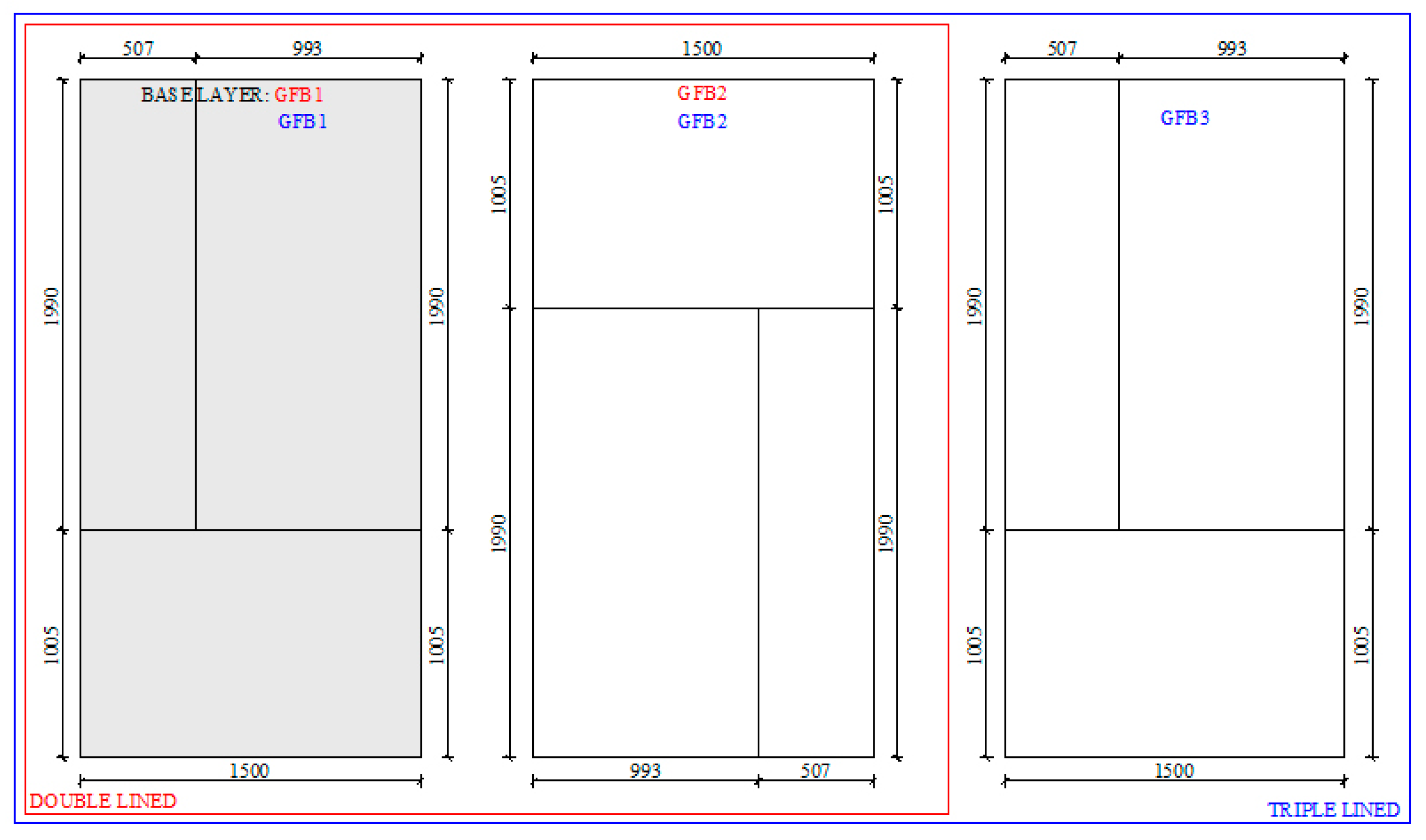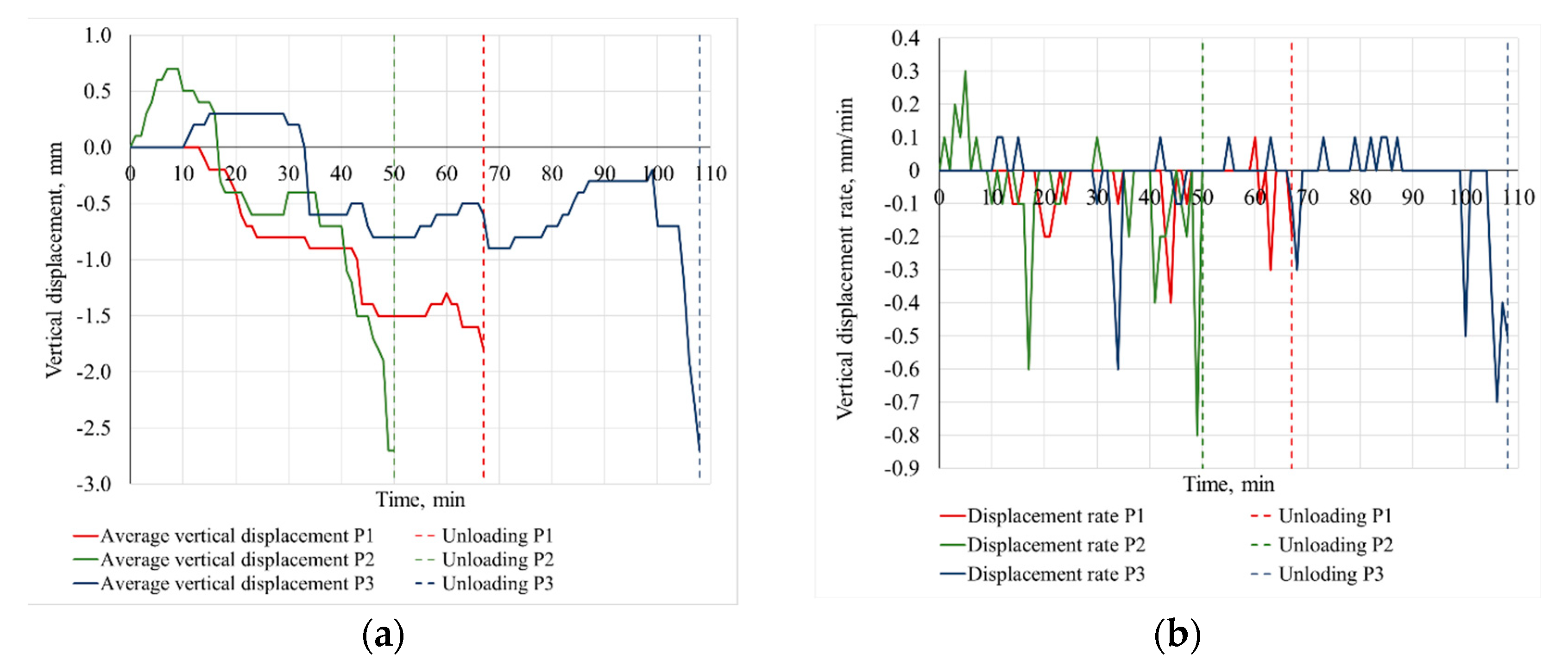Fire Tests of Load-Bearing, Light-Steel-Framed Wall Systems Insulated with Polyurethane Foam
Abstract
:1. Introduction
2. Experimental Study
2.1. Test Specimen Components and Construction
2.2. Thermocouple Arrangement
- Between wallboard layers on both sides (ambient and fire side)—labelled 1, 2, 6 and 7 for double-lined specimens and 1, 2, 3, 7, 8 and 9 for triple-lined specimens.
- On the hot and cold flanges and on the web of the lipped channel, C-shaped steel studs—marked 3, 4 and 5 for double-lined specimens and 4, 5 and 6 for triple-lined specimens.
2.3. Test Set-Up and Fire Test Methodology
3. Test Observations and Results
3.1. Specimen P1
3.2. Specimen P2
3.3. Specimen P3
3.4. Post-Test Observations
4. Discussion
4.1. Overall Behaviour of Tested Specimens
4.2. Comparison between Nominally Identical Specimens (P1 and P2)
4.3. Comparison between Specimens with Different Wallboard Layers (P1 and P3)
5. Conclusions
- During testing, the integrity and insulating properties of the tested LSF panels were undisputed, and all test specimens showed indications of structural collapse. Nevertheless, a reliable mode of failure (governing the FRR criteria) cannot be specified because the insulation used is combustible and the tests were terminated before the failure criteria were reached.
- Two 12.5 mm thick layers of A1 GBFs delayed the temperature rise in the steel bars by about 50 min (observed at lower positions of thermocouples) to 60 min (observed at higher position of thermocouples), while the configuration with two A2 GBFs and an outer A1 GFB caused an additional delay of 30 min.
- Post-fire test observations showed that all three test specimens exhibited similar local buckling of the steel members in the lower segment near the rigid nodes.
- The results obtained on two identical specimens under the same conditions demonstrate the need to perform a larger number of nominally identical tests, especially to broaden the basis for verification when fire behaviour modelling is used.
Author Contributions
Funding
Institutional Review Board Statement
Informed Consent Statement
Data Availability Statement
Conflicts of Interest
References
- Soares, N.; Santos, P.; Gervásio, H.; Costa, J.J.; da Silva, L.S. Energy efficiency and thermal performance of lightweight steel-framed (LSF) construction: A review. Renew. Sustain. Energy Rev. 2017, 78, 194–209. [Google Scholar] [CrossRef]
- Rodrigues, E.; Soares, N.; Fernandes, M.S.; Gaspar, A.R.; Gomes, Á.; Costa, J.J. An integrated energy performance-driven generative design methodology to foster modular lightweight steel framed dwellings in hot climates. Energy Sustain. Dev. 2018, 44, 21–36. [Google Scholar] [CrossRef]
- Jerónimo, R.; Gonçalves, M.; Furtado, C.; Rodrigues, K.; Ferreira, C.; Simões, N. Experimental Assessment and Validation of the Hygrothermal Behaviour of an Innovative Light Steel Frame (LSF) Wall Incorporating a Monitoring System. Buildings 2023, 13, 2509. [Google Scholar] [CrossRef]
- Ariyanayagam, A.D.; Mahendran, M. Experimental study of load-bearing cold-formed steel walls exposed to realistic design fires. J. Struct. Fire Eng. 2014, 5, 291–329. [Google Scholar] [CrossRef]
- Ariyanayagam, A.D.; Mahendran, M. Fire tests of non-load bearing light gauge steel frame walls lined with calcium silicate boards and gypsum plasterboards. Thin-Walled Struct. 2017, 115, 86–99. [Google Scholar] [CrossRef]
- EN 13501-2; Fire Classification of Construction Products and Building Elements—Part 2: Classification Using Data from Fire Resistance Tests, Excluding Ventilation Services. CEN The European Committee for Standardization: Brussels, Belgium, 2016.
- Wang, Y.; Burgess, I.; Wald, F.; Gillie, M. Performance-Based Fire Engineering of Structures; CRC Press: Boca Raton, FL, USA, 2012. [Google Scholar]
- Gunalan, S.; Kolarkar, P.; Mahendran, M. Experimental study of load bearing cold-formed steel wall systems under fire conditions. Thin-Walled Struct. 2013, 65, 72–92. [Google Scholar] [CrossRef]
- Kodur, V.K.R.; Sultan, M.A. Factors influencing fire resistance of load-bearing steel stud walls. Fire Technol. 2006, 42, 5–26. [Google Scholar] [CrossRef]
- Alves, M.H.; Constantini, G.; Ianni, A.; Kimura, E.F.A.; Meda, A.; Piloto, P.A.G. Fire performance of non-load-bearing double-stud light steel frame walls: Experimental tests, numerical simulation, and simplified method. Fire Mater. 2022, 46, 227–250. [Google Scholar] [CrossRef]
- Steau, E.; Mahendran, M. Elevated temperature thermal properties of fire protective boards and insulation materials for light steel frame systems. J. Build. Eng. 2021, 43, 102571. [Google Scholar] [CrossRef]
- Gnanachelvam, S.; Mahendran, M.; Ariyanayagam, A. Elevated temperature thermal properties of advanced materials used in LSF systems. Fire Mater. 2022, 46, 12–28. [Google Scholar] [CrossRef]
- Just, A.; Schmid, J.; König, J. Gypsum Plasterboards Used as Fire Protection—Analysis of a Database; SP Technical Research Institute of Sweden: Stockholm, Sweden, 2010; p. 30. [Google Scholar]
- Keerthan, P.; Mahendran, M. Thermal Performance of Composite Panels Under Fire Conditions Using Numerical Studies: Plasterboards, Rockwool, Glass Fibre and Cellulose Insulations. Fire Technol. 2013, 49, 329–356. [Google Scholar] [CrossRef]
- Santos, P.; Martins, C.; Simões da Silva, L. Thermal performance of lightweight steel- framed construction systems. Metall. Res. Technol. 2014, 111, 329–338. [Google Scholar] [CrossRef]
- Ariyanayagam, A.D.; Mahendran, M. Influence of cavity insulation on the fire resistance of light gauge steel framed walls. Constr. Build. Mater. 2019, 203, 687–710. [Google Scholar] [CrossRef]
- Ariyanayagam, A.D.; Mahendran, M. Fire performance of load bearing LSF wall systems made of low strength steel studs. Thin-Walled Struct. 2018, 130, 487–504. [Google Scholar] [CrossRef]
- Alfawakhiri, F.; Sultan, M.A. Fire Resistance of Loadbearing LSF Assemblies. In Proceedings of the International Specialty Conference on Cold-Formed Steel Structures: Recent Research and Developments in Cold-Formed Steel Design and Construction, St. Louis, MO, USA, 19–20 October 2000; University of Missouri—Rolla: Rolla, MO, USA, 2000; pp. 545–561. [Google Scholar]
- Tao, Y.; Mahendran, M. Fire tests and thermal analyses of LSF walls insulated with silica aerogel fibreglass blanket. Fire Saf. J. 2021, 122, 103352. [Google Scholar] [CrossRef]
- Perera, D.; Poologanathan, K.; Gillie, M.; Gatheeshgar, P.; Sherlock, P.; Nanayakkara SM, A.; Konthesingha, K.M. C Fire performance of cold, warm and hybrid LSF wall panels using numerical studies. Thin-Walled Struct. 2020, 157, 107109. [Google Scholar] [CrossRef]
- Gnanachelvam, S.; Ariyanayagam, A.; Mahendran, M. Fire resistance of LSF wall systems lined with different wallboards including bio-PCM mat. J. Build. Eng. 2020, 32, 101628. [Google Scholar] [CrossRef]
- Somarathna, H.M.C.C.; Raman, S.N.; Mohotti, D.; Mutalib, A.A.; Badri, K.H. The use of polyurethane for structural and infrastructural engineering applications: A state-of-the-art review. Constr. Build. Mater. 2018, 190, 995–1014. [Google Scholar] [CrossRef]
- Liu, X.; Hao, J.; Gaan, S. Recent studies on the decomposition and strategies of smoke and toxicity suppression for polyurethane based materials. RSC Adv. 2016, 6, 74742–74756. [Google Scholar] [CrossRef]
- Singh, H.; Jain, A.K. Ignition; combustion; toxicity, and fire retardancy of polyurethane foams: A comprehensive review. J. Appl. Polym. Sci. 2009, 111, 1115–1143. [Google Scholar] [CrossRef]
- Thomas McKenna, S.; Hull, T.R. The fire toxicity of polyurethane foams. Fire Sci. Rev. 2016, 5, 3. [Google Scholar] [CrossRef]
- Paabo, M.; Levin, B.C. A review of the literature on the gaseous products and toxicity generated from the pyrolysis and combustion of rigid polyurethane foams. Fire Mater. 1987, 11, 1–29. [Google Scholar] [CrossRef]
- Amado, J.C.Q. Thermal Resistance Properties of Polyurethanes and its Composites: A Short Review. J. Res. Updat. Polym. Sci. 2019, 66–84. [Google Scholar] [CrossRef]
- Günther, M.; Lorenzetti, A.; Schartel, B. From Cells to Residues: Flame-Retarded Rigid Polyurethane Foams. Combust. Sci. Technol. 2020, 192, 2209–2237. [Google Scholar] [CrossRef]
- Le Dréau, J.; Jensen, R.L.; Kolding, K. Thermal behaviour of a gypsum fibre board associated with rigid polyurethane foam under standard fire conditions. Energy Procedia 2015, 78, 2736–2741. [Google Scholar] [CrossRef]
- Rukavina, M.J.; Skejić, D.; Kralj, A.; Ščapec, T.; Milovanović, B. Development of Lightweight Steel Framed Construction Systems for Nearly-Zero Energy Buildings. Buildings 2022, 12, 929. [Google Scholar] [CrossRef]
- Fermacell ®. “Fermacell ® Gypsum Fibreboards Product Data Sheet, no. 5–6 October 2019. Available online: https://www.fermacell.co.uk/fermacellapi/downloads/file/en-GB/0690J000004BxHIQA0 (accessed on 20 September 2023).
- Fermacell ®. “Fermmacell Firepanel A1 Product Data Sheet. October 2019. Available online: https://www.fermacell.co.uk/fermacellapi/downloads/file/en-GB/0690J000004BxFgQAK (accessed on 20 September 2023).
- EN 1365-1; Fire Resistance Tests for Loadbearing Elements—Part 1: Walls. CEN The European Committee for Standardization: Brussels, Belgium, 2012; p. 25.
- EN 1363-1; Fire Resistance Tests—Part 1: General Requirements. CEN The European Committee for Standardization: Brussels, Belgium, 2020.
- Thomas, G. Thermal properties of gypsum plasterboard at high temperatures. Fire Mater. 2002, 26, 37–45. [Google Scholar] [CrossRef]
- Ang, C.N.; Wang, Y.C. Effect of moisture transfer on specific heat of gypsum plasterboard at high temperatures. Constr. Build. Mater. 2009, 23, 675–686. [Google Scholar] [CrossRef]
- Melcher, T.; Zinke, R.; Trott, M.; Krause, U. Experimental investigations on the repeatability of real scale fire tests. Fire Saf. J. 2016, 82, 101–114. [Google Scholar] [CrossRef]













Disclaimer/Publisher’s Note: The statements, opinions and data contained in all publications are solely those of the individual author(s) and contributor(s) and not of MDPI and/or the editor(s). MDPI and/or the editor(s) disclaim responsibility for any injury to people or property resulting from any ideas, methods, instructions or products referred to in the content. |
© 2024 by the authors. Licensee MDPI, Basel, Switzerland. This article is an open access article distributed under the terms and conditions of the Creative Commons Attribution (CC BY) license (https://creativecommons.org/licenses/by/4.0/).
Share and Cite
Jelčić Rukavina, M.; Skejić, D.; Milovanović, B.; Ščapec, T. Fire Tests of Load-Bearing, Light-Steel-Framed Wall Systems Insulated with Polyurethane Foam. Appl. Sci. 2024, 14, 637. https://doi.org/10.3390/app14020637
Jelčić Rukavina M, Skejić D, Milovanović B, Ščapec T. Fire Tests of Load-Bearing, Light-Steel-Framed Wall Systems Insulated with Polyurethane Foam. Applied Sciences. 2024; 14(2):637. https://doi.org/10.3390/app14020637
Chicago/Turabian StyleJelčić Rukavina, Marija, Davor Skejić, Bojan Milovanović, and Tomislav Ščapec. 2024. "Fire Tests of Load-Bearing, Light-Steel-Framed Wall Systems Insulated with Polyurethane Foam" Applied Sciences 14, no. 2: 637. https://doi.org/10.3390/app14020637
APA StyleJelčić Rukavina, M., Skejić, D., Milovanović, B., & Ščapec, T. (2024). Fire Tests of Load-Bearing, Light-Steel-Framed Wall Systems Insulated with Polyurethane Foam. Applied Sciences, 14(2), 637. https://doi.org/10.3390/app14020637







